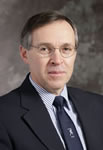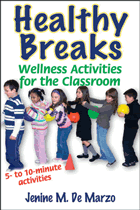EDITORIAL
Solving the Teaching Skills vs. Getting Students
Active Conundrum

PE
Teacher: Should our focus in physical education
be on teaching skills or getting students
physically active?
PE Philosopher: Yes
I recently listened to America's PE and sport
philosopher-laureate Scott Kretchmar and just
as intended it made me think. To the delight
of our diminishing but indispensible cadre
of PE philosophers, the seemingly frustrating
and unresolvable conundrum that physical education
teachers face is in fact answerable: Well
at least from a philosopher's world view!
Master of Science
Online
Physical Education & Athletic Administration
Options
Central Washington University
Starting Summer 2014
Contact Dr. Kirk
Mathias for details
mathiask@cwu.edu
|
Last month, Mike Metzler eloquently and persuasively
described the HOPE curriculum model in which
he advocated the promotion of physical activity
as the way to move our profession forward
into the 21st century. This month pelinks4u
also includes an article by Martin Donahue
supporting the HOPE message.
But in It's all about Student Learning!
National Standards and Grade-Level Outcomes
for K - 12 Physical Education, Lynn Couturier
former NASPE President and lead writer for
the recently released new NASPE Standards
and Outcomes, sees the world differently.
For a wide variety of research-supported reasons,
Lynn points to the importance of physical
educators focusing first and foremost on helping
students to develop motor skills. It's a view
difficult to argue against.
What's a teacher to do? Well, our philosopher
friends would likely encourage us to stop
seeing the question in either-or terms. A
continuum might fit better. And for those
of us more comfortable thinking of things
from a "what-does-it look-like-in-practice?"
perspective, this view works.
If you think about it, some students simply
enjoy being physically active and aren't much
interested in physical activities that require
high skill competence or encourage competition.
In contrast, others seek out competition.
They're motivated to be physically active
to compete against others in situations that
demand high-level skills. We see these different
attitudes toward movement not just in children
but also in adults.
I'm not going to risk reader wrath by attempting
to label or categorize specific activities
or sports, but rather simply point out that
people are different and that it's a mistake
for us to teach physical education with a
"one size fits all" mentality. Devoting the
time needed to become competent in a skill
motivates some and bores others. And even
then, attitudes will differ between the types
of skills being taught.
What this means to me is that we'd probably
do much better to stop seeing different approaches
to teaching physical education as polemic
opposites and think more about how best to
meet individual student needs and motivations:
A challenging enough task with one person,
let alone a class of 30 or more!
Adding to the discussion, former AAHPERD
President Ron Feingold offers his own take
on what the purpose of physical education
should be. As the title, Adult Behaviors
Should Guide Physical Education suggests,
Ron thinks we should plan backwards from our
ultimate goal. He suggests that asking ourselves
what physical activity behaviors we'd like
to see among adults can help us make the best
decisions about what to teach our school-aged
children.
In addition to essays challenging us to think
about the purpose of physical education, pelinks4u
this month has much more including an essay
from Craig Buschner, another former NASPE
President, who is concerned about the explosive
growth of physical education classes being
delivered online. Everyone excited or frustrated
with the way in which technology is affecting
physical education will enjoy Craig's essay.
Paul Clinton completes his three-part series
on advocacy with an article this month entitled
Advocating for our profession; Crafting
Your Message. Then Laura Zavatto and
Isobel Kleinman in two separate articles describe
some activities they use to promote heart
health - particularly appropriate in Heart
Month.
pelinks4u is also proud to feature
two special submissions that remember two
professional leaders who passed away at the
end of 2013. Seymour (Sy) Kleinman and John
Massengale were both physical education visionaries
in very different ways. We appreciate John
Kilbourne and Steve Estes remembering their
mentors, colleagues, and friends in these
personal tributes.
Please be sure to share these essays and
articles with your colleagues and students
via email and Facebook. Also, remember to
look at the News columns for what's happening
professionally around the country and in different
parts of the world. Finally, we'd also be
delighted to hear your thoughts and suggestions.
Enjoy. More thought-provoking contributions
promised next month too! Have a great Heart
Month.
Best Regards,
Steve
Jefferies, pelinks4u publisher |















